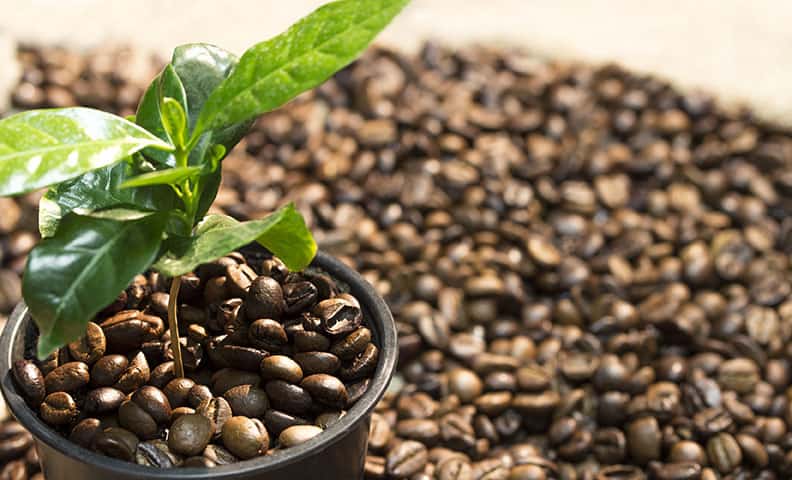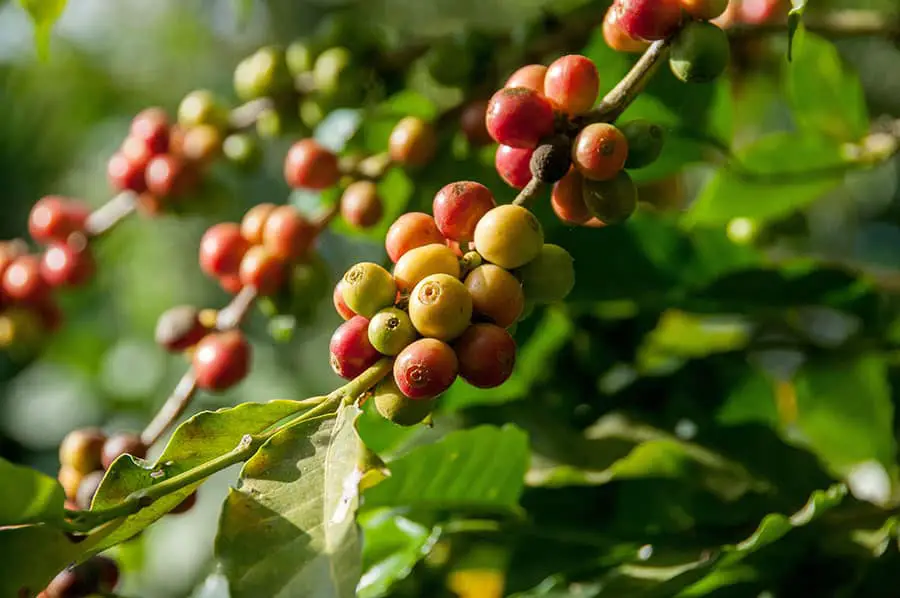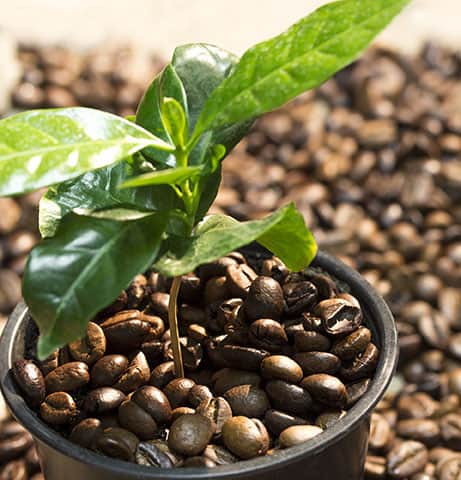
Have you ever considered growing your own coffee plant at home? Not only is it a fun and rewarding project, but it also provides the opportunity to enjoy a fresh cup of coffee made from your very own beans. Growing a coffee plant at home is relatively easy, but it does require a little bit of patience and some specific care requirements.
In this blog post, we will explore the steps needed to successfully grow a coffee plant in your home, from obtaining seeds or a young plant, to providing the right light and soil conditions, to harvesting your own coffee beans.
How to Grow A Coffee Plant at Home
Here are the steps for growing a coffee plant at home in more detail:
1. Obtain a coffee plant or coffee plant seeds
You can purchase a young coffee plant from a local nursery or online retailer, or you can start from seeds. If starting from seeds, make sure to buy high-quality, fresh coffee seeds and plant them in a seed tray filled with moist, well-draining seed compost.
Regardless of which species you end up purchasing, the actual growth and care process of coffee plants remains largely the same. Coffee plants are generally only grown in hot, humid climates, so if you live in a region that experiences drastic seasonal temperature changes, you’re going to want to keep your plant indoors.
2. Choose a pot
Coffee plants can grow quite large, so it’s important to choose a pot that has adequate room for the roots to grow. A pot with drainage holes is also essential to prevent waterlogging, which can lead to root rot. Fill the pot with a good quality, well-draining potting soil.
3. Plant the coffee plant or seedlings
If you are planting a young coffee plant, gently remove it from its original pot and place it in the new pot, filling in any gaps in the soil around the roots with fresh soil. Water the plant thoroughly to settle the soil around the roots. If starting from seeds, plant the seedlings in the pot once they are big enough to handle, and again, water thoroughly.
To begin growing a coffee plant at home you will need nutrient rich soil, a temperature between 60 – 80 Fahrenheit, 4 to 5 hours of sunlight as well as damp but not water logged soil and patience
Regardless of whether you’re growing your coffee plant inside or outside, you’re going to want to make sure that the temperature remains between 60°F and 80°F during the day, and never dips below 45°F at night.
4. Provide proper light
Coffee plants prefer bright, indirect light, so place your plant near a sunny window, but not in direct sunlight, which can scorch the leaves. If you live in a location with low light levels, you may need to use artificial lighting to supplement the plant’s light needs.
5. Watering
Coffee plants prefer consistently moist soil, but not waterlogged. Keep the soil consistently moist, but be careful not to over-water, as this can lead to root rot. Let the top inch of soil dry out between waterings.
6. Fertilizing
Coffee plants benefit from regular fertilization, especially during the growing season. Use a balanced, water-soluble fertilizer and follow the package instructions for application rates. Fertilize every 4-6 weeks during the growing season.
7. Pruning
Regular pruning helps to keep the coffee plant healthy and encourages bushier growth. Prune the plant to remove any yellowing or diseased leaves, and to shape the plant as desired.
Note: Coffee plants are susceptible to pests and diseases, so it’s important to keep an eye out for any signs of problems and to treat them promptly. Additionally, coffee plants have specific temperature and humidity requirements, so be sure to research the specific care needs of the type of coffee plant you have. With proper care, a coffee plant can grow and produce coffee beans for several years.
Caring For Your Coffee Plant
On coffee farms, coffee plants are planted under the shade of larger trees, so that they’re exposed to a good amount of sunlight, but are not stranded under the full force of the sun’s rays.
To replicate this ideal amount of sunlight, place your coffee plant close to a bright window, but not directly next to it. If your plant is too close to direct sunlight, the leaves might shrivel or even burn.
Ideally, your coffee plant should be exposed to sunlight for about 4 or 5 hours of the day. If your home doesn’t have a bright window, you might want to consider buying a timed fluorescent or full-spectrum light bulb to replicate sunlight.
Again, coffee plants thrive in wet, humid climates. For the most ideal results, you’re going to want to water your coffee plant every single day. The soil should be constantly damp, but not water-logged. An easy way to water your coffee plant is to put the entire pot in your kitchen sink and run the faucet over it. Once you’ve thoroughly saturated the pot with water, let it drain for a few minutes.
This way, the entirety of the soil gets hydrated, but you avoid over-watering. If the leaves of your coffee plant ever look wilted, dry, or brown and crinkly, that’s an almost-sure sign that you haven’t been watering it enough.
A good rule of thumb, you should never let the soil in your coffee plant’s pot get bone-dry. It should always be at least a little bit damp.
You’re also going to want to make sure that your coffee plant’s soil is nice and nutrient-rich so that the plant has everything it needs to grow strong and healthy.
If you’re buying fertilizer at your local hardware store or gardening shop, look for a brand whose label boasts “micro nutrients.” You’re also going to want to use a fertilizer that’s water-soluble. Be careful, though. Just like it’s possible to under-fertilize your plant, it’s equally as possible to over-fertilize it.
What kinds of Coffee Trees are grown at Home?
The two most common and popular species of coffee are Coffea arabica and Coffea robusta. Both species are equally accessible, but depending on your coffee-drinking preferences, either one or the other will be better suited for you. Arabica is the most commonly grown and consumed species of coffee on the planet. However, its plants are notoriously fickle.
They grow very slowly and are relatively fragile, requiring a lot of care, attention, and upkeep.
That being said, most coffee connoisseurs agree that a quality Arabica bean is absolutely unmatched in terms of flavor and complexity. With the proper care and preparation, Arabica coffee has well-balanced notes of fruit, sweetness, nuttiness, chocolate, and acidity. Robusta is the second most common coffee species. Its plants grow much faster than Arabica.
Robusta plants are also well-known for being much hardier and more durable than their fragile counterparts. Plus, Robusta beans have almost double the caffeine content of Arabica beans.
The downside is that Robusta beans are generally much more bitter than Arabica beans, which many people find distasteful. However, if you like your coffee dark, strong, and bitter, you might enjoy growing your own Robusta!
What is the best time of year to grow a Coffee Plant ?

From March through October, you’re going to want to fertilize your coffee plant every two weeks.From November to February, decrease your fertilization frequency to once a month.
If the leaves of your coffee plant begin to look brown around the edges,that means that you might be over-fertilizing it. If that happens, cut down the number of times that you use fertilizer until the leaves return to their green color.
As your plant grows, you’re going to need to re-pot it into larger and larger containers, so that the roots have room to spread and grow. At its full size, your coffee plant might reach up to 10 feet tall! For the first couple of years, your coffee plant probably won’t flower.
Again, this is because coffee plants take a very long time to mature and bear fruit. However, once it’s reached a mature enough stage it’ll begin to grow small white flowers that smell like citrus and jasmine.
They’ll only last for a couple of days before wilting, though, so enjoy them while you can! These little flowers are an indication that your plant has reached a mature enough level to begin bearing fruit! 1 to 2 months after fertilization, little green coffee fruits, also known as “coffee cherries,” will begin to grow.
Coffee plants are self-fertilizing, so you don’t have to worry about manually cross-pollinating yours. Once the coffee cherries begin to appear, you’ll know that you’re one step closer to harvesting some delicious coffee beans!
Don’t get too excited, though. Coffee cherries are not ready to harvest until they turn firm and bright red, which can take 8 or 9 months from the moment that they form. Not all of the coffee cherries will ripen at exactly the same time,so you’re going to want to watch your coffee plant every day to see if any cherries have ripened.
Can I Roast Coffee from a Coffee Plant I grow at home?
Once you’ve harvested your coffee cherries, you’re going to want to start prepping them for the roasting process as soon as possible, within 24 hours at the absolute longest. Each coffee cherry has two seeds, which will eventually become coffee beans after the entire roasting process has been completed.
The process of removing these seeds from the cherries is called pulping. To pulp your cherries at home, you can squeeze out the seeds from each individual cherry by hand, one by one, which can be quite a laborious and time-consuming process. (See my post on Coffee Processing)
However, if you don’t have very many coffee cherries that are ready to harvest, this process probably won’t take too long. If you have a lot of coffee cherries that need to be pulped, you can also put all of your coffee cherries in a bucket and use a piece of wood to smash the berries until all of the seeds have been squeezed out.
Once all the seeds and fruits have been separated, fill the bucket with water and stir the mixture around.
The skins and pulp will float to the top, where you can skim them out. Good coffee beans will sink to the bottom. You should also skim out any coffee beans that float to the top with the skins and pulp, because they’ve probably gone bad. Once you’ve removed all of the skins, pulp, and bad coffee beans, then you can drain the water out of the bucket to reveal a collection of coffee seeds!
Final Thoughts
Although this might seem counter intuitive, it’s actually not a very good idea to grow a coffee plant from seed in your own home, especially if you’re hoping to harvest and consume the coffee beans it produces.
Coffee plants are notorious for their excruciatingly slow growth and maturation process. If you were to buy coffee seeds, plant them, and wait until they were ready to be harvested, you’d be waiting for 8 to 10 years!
Even for the most patient of coffee lovers, this time-consuming process might be a little too long. Instead, you should purchase an already-potted coffee plant, which will mature and begin to produce fruit in 3 to 4 years. That’s still quite a long time, but it’s certainly more realistic than growing an entire mature coffee plant from seed.
If you live near a specialty greenhouse or hardware store with an extensive garden department, you might be able to buy a potted coffee plant in person. If not, potted coffee plants are also available on Amazon and eBay for a very reasonable price.
If you’re really serious about growing your own coffee plant, it can also be an incredibly gratifying and rewarding experience – Give it a Try and let me know how it goes!


